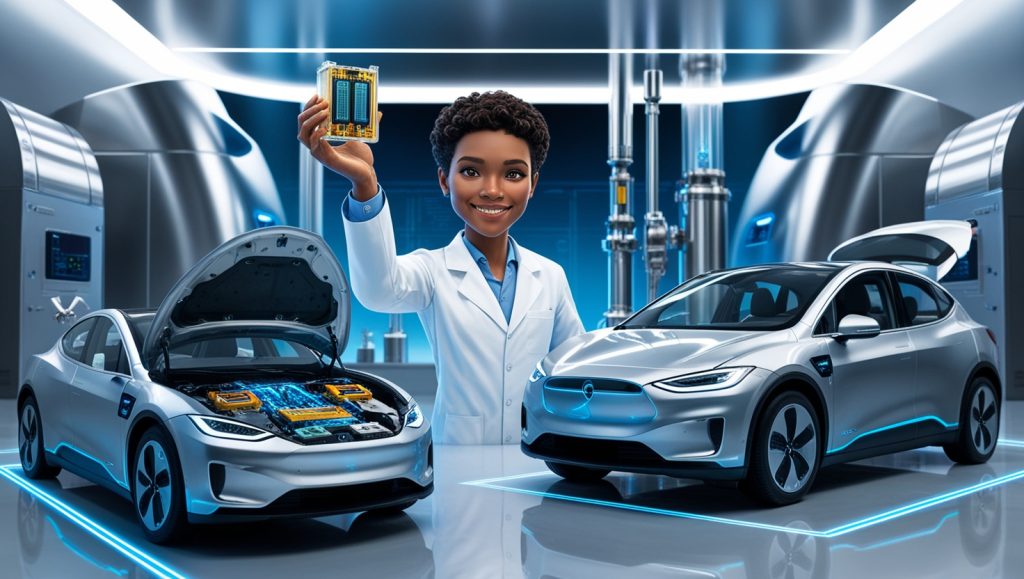The world of energy storage is on the brink of a transformative shift, thanks to the invention and development of solid-state batteries. This innovative technology is set to revolutionize multiple industries, especially the automobile sector, which is increasingly transitioning toward electric vehicles (EVs). Solid-state batteries promise to solve many of the challenges posed by traditional lithium-ion batteries, offering enhanced safety, faster charging times, and greater energy efficiency. But who invented this game-changing technology, what is the science behind it, and how will it impact the future of the automobile industry?

Who Invented Solid-State Battery Technology?
The concept of solid-state batteries has been under research for decades, but it was first proposed in the 1950s by German scientist Michael Faraday in his early studies of solid electrolytes. However, it did not progress significantly until recent years , largely due to breakthroughs in materials science and increased funding from both the private sector and government bodies.
A pivotal figure in the modern development of solid-state battery technology is John B. Goodenough, the same scientist who co-invented the lithium-ion battery in the 1980s. Goodenough’s continued work on solid-state technology at the University of Texas has paved the way for its potential commercialization. Companies like Toyota, Samsung, and QuantumScape, a Silicon Valley startup backed by Volkswagen and Bill Gates, have also been instrumental in pushing solid-state batteries closer to mass production. In 2020, QuantumScape announced significant advancements in solid-state battery technology, positioning itself as a leader in this emerging field.
The Science Behind Solid-State Batteries
At the heart of solid-state batteries lies a fundamental change in their internal structure compared to traditional lithium-ion batteries. In conventional lithium-ion batteries, the electrolyte—the substance that allows ions to move between the positive and negative electrodes—is in liquid form. While effective, liquid electrolytes can be flammable, less stable, and prone to degradation over time.
Solid-state batteries, as the name suggests, use a solid electrolyte instead of a liquid one. This solid electrolyte can be made from a variety of materials, including ceramics, sulfides, or polymers. The solid electrolyte offers several advantages:
- Higher Energy Density: Solid-state batteries can store more energy in the same physical space because the solid electrolyte allows for tighter packing of the battery’s components. This higher energy density translates to longer-lasting power in devices and electric vehicles.
- Safety and Stability: Unlike liquid electrolytes, which can overheat and lead to battery fires, solid electrolytes are non-flammable and more stable. This greatly reduces the risk of overheating, leaks, and other safety concerns.
- Faster Charging Times: The solid electrolyte structure allows for faster ion movement between electrodes, enabling quicker charging. In some cases, solid-state batteries can be charged up to 80% in just 15 minutes, a significant improvement over current lithium-ion batteries.
- Longer Lifespan: Solid-state batteries experience less wear and tear during charge cycles because they do not rely on the liquid electrolyte’s chemical reactions, which degrade over time. This means they last longer, making them more cost-effective in the long run.
Impact on the Future of the Automobile Industry
Aparently, the Solid-state batteries are going to revolutionize the automobile industry, particularly in the realm of electric vehicles (EVs). As global demand for EVs continues to rise—driven by concerns over climate change, government regulations, and consumer preferences—battery technology has become a critical bottleneck. Solid-state batteries offer a solution to many of the current limitations of lithium-ion batteries used in EVs today.
Here are some key ways solid-state batteries will impact the future of automobiles:
The Road Ahead
While solid-state batteries are not yet widely available, the race to commercialize this technology is in full swing. Companies like Toyota aim to roll out solid-state battery-powered EVs within the next few years, while others, including QuantumScape, are targeting large-scale production by the late 2020s. The promise of safer, longer-lasting, and faster-charging batteries is sparking a new era in both energy storage and the automotive industry.
Longer Driving Range:
One of the most significant advantages of solid-state batteries for EVs is their higher energy density, which allows for longer driving ranges on a single charge. Many electric vehicles today have a range of about 200-300 miles per charge, but the newly invented batteries could push that figure well beyond 500 miles, addressing one of the major concerns of EV adoption—range anxiety.
Faster Charging:
Solid-state batteries promise much faster charging times compared to lithium-ion batteries. This could reduce charging time from hours to mere minutes, making EVs more convenient and practical for long-distance travel. Such a development would likely accelerate the transition away from gas-powered vehicles.
Improved Safety:
The use of non-flammable solid electrolytes means that the risk of battery fires—an issue that has affected some EV models—would be drastically reduced. This enhanced safety feature will make electric vehicles more attractive to consumers and manufacturers alike.
Reduced Manufacturing Costs:
While solid-state battery technology is still expensive to produce at scale, it has the potential to become cheaper over time due to lower material and maintenance costs. EV manufacturers could eventually offer more affordable vehicles, driving widespread adoption.
Environmental Impact:
With solid-state batteries lasting longer and being more efficient, the environmental footprint of producing, maintaining, and recycling EV batteries could be significantly reduced. This will align with global efforts to create greener, more sustainable modes of transportation.
As these batteries continue to mature, they will likely become the foundation for next-generation electric vehicles. This technological leap could dramatically accelerate the global transition to cleaner energy and transportation, reshaping not just the automobile industry but the entire energy landscape for decades to come.
